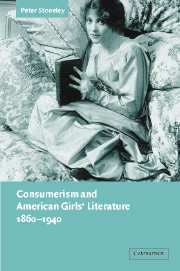Introduction: “Buying into womanhood”
Published online by Cambridge University Press: 22 September 2009
Summary
Why did the girl – the girl at the “awkward age” – come to dominate the American imagination from the nineteenth century into the twentieth? By way of answer, this book looks at the way in which women fictionalized the process of “buying into womanhood”; at how, during the rise of consumerism, they envisaged for the girl reader and others the ways of achieving a powerful social and cultural presence. I explore why and how this scenario of buying into womanhood became, between 1860 and 1940, one of the nation's central allegories, one of its favourite means of negotiating social change. The exemplary novelistic scenario here is that of the “backwoods” girl-heroine who achieves a love-match with a successful but disillusioned middle-aged businessman. In managing this, the girl also manages, in concentrated symbolic form, to enact the progress of fifty years. She moves from a modest, rural background to urban, monied display. The girl allows fiction – and the culture generally – to perform a series of other-wise awkward maneuvers: between country and metropolis, “uncouth” and “unspoilt,” modern and anti-modern. While her gender identifies her as malleable, her youth symbolizes the vitality of an earlier America. She serves to mitigate the perception that the modern age is, to adopt the terms of the period, “artificial.” Her “breathless audacity” stands in contrast to the “weightlessness” and “blandness” of a systematized and incorporated nation.
- Type
- Chapter
- Information
- Publisher: Cambridge University PressPrint publication year: 2003



